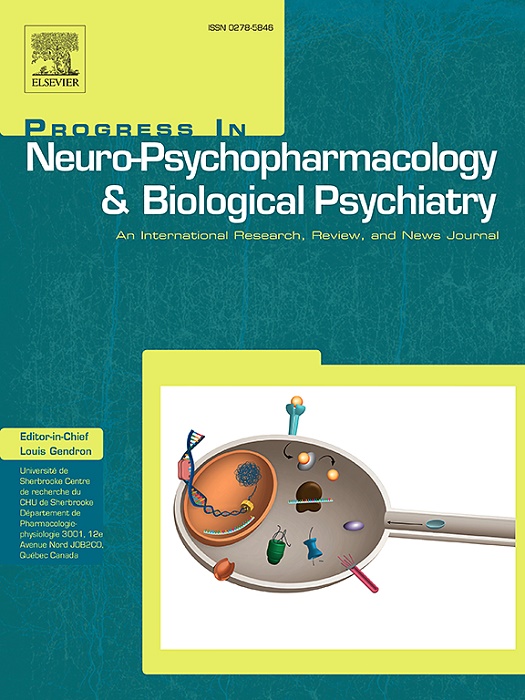易受产前应激暴露的成年动物的性别特异性代谢和炎症改变
IF 5.3
2区 医学
Q1 CLINICAL NEUROLOGY
Progress in Neuro-Psychopharmacology & Biological Psychiatry
Pub Date : 2025-03-24
DOI:10.1016/j.pnpbp.2025.111344
引用次数: 0
摘要
早期生活压力(ELS)是生命后期情绪和代谢障碍发展的重要危险因素,这通常是合并症。虽然众所周知,并非所有暴露于ELS的个体都会患上这些疾病,但导致易受伤害或有弹性的情绪和代谢紊乱的机制,作为ELS暴露的后果,仍未完全了解。在这项研究中,我们使用产前应激(PNS)模型,模拟围产期逆境,研究ELS对成年雄性和雌性后代代谢功能、应激相关和炎症标志物的影响,特别关注脆弱或弹性表型。PNS暴露与肝脏和腹侧海马体中应激相关和代谢标志物的失调有关,易感雄性表现出胰岛素受体水平升高和脂肪因子受体(如瘦素和脂联素)表达失调。相比之下,雌性动物没有表现出这些变化。此外,PNS诱导易感雄性大鼠腹侧海马体出现明显的神经炎症反应,其特征是小胶质细胞激活标志物上调。有趣的是,无论病理表型如何,在pns暴露的男性肝脏中观察到类似的促炎状态;然而,抗炎标志物仅在弹性动物中上调,表明弹性的积极机制。这些发现表明,特定的代谢和炎症变化是PNS易感表型发病的基础,具有性别特异性效应,并强调了靶向这些途径在治疗情绪障碍和代谢合并症中的重要性。本文章由计算机程序翻译,如有差异,请以英文原文为准。
Sex-specific metabolic and inflammatory alterations in adult animals vulnerable to prenatal stress exposure
Early life stress (ELS) is a significant risk factor for the development of mood and metabolic disorders later in life, which are often in comorbidity. Although it is well known that not all the exposed individuals develop these conditions, the mechanisms leading to a vulnerable or a resilient phenotype for mood and metabolic disorders, as consequences of ELS exposure, are still not fully understood. In this study, we used a prenatal stress (PNS) model, mimicking perinatal adversities, to investigate the impact of ELS on metabolic function, stress-related and inflammatory markers in adult male and female offspring, with a particular focus on vulnerable or resilient phenotypes. PNS exposure was associated with a dysregulation of stress-related and metabolic markers both in the liver and also in the ventral hippocampus, with vulnerable males exhibiting increased insulin receptor levels and dysregulated expression of adipokine receptors (such as leptin and adiponectin). In contrast, female animals did not exhibit these changes. Additionally, PNS induced a pronounced neuroinflammatory response in the ventral hippocampus of vulnerable male rats, characterized by an upregulation of microglial activation markers. Interestingly, a similar pro-inflammatory status was observed in the liver of PNS-exposed males regardless of the pathologic phenotype; however, anti-inflammatory markers were upregulated only in resilient animals, suggesting an active mechanism of resilience. These findings suggest that specific metabolic and inflammatory changes underlie, with a sex-specific effect, the onset of a vulnerable phenotype to PNS and highlight the importance of targeting these pathways in the treatment of mood disorders and metabolic comorbidities.
求助全文
通过发布文献求助,成功后即可免费获取论文全文。
去求助
来源期刊
CiteScore
12.00
自引率
1.80%
发文量
153
审稿时长
56 days
期刊介绍:
Progress in Neuro-Psychopharmacology & Biological Psychiatry is an international and multidisciplinary journal which aims to ensure the rapid publication of authoritative reviews and research papers dealing with experimental and clinical aspects of neuro-psychopharmacology and biological psychiatry. Issues of the journal are regularly devoted wholly in or in part to a topical subject.
Progress in Neuro-Psychopharmacology & Biological Psychiatry does not publish work on the actions of biological extracts unless the pharmacological active molecular substrate and/or specific receptor binding properties of the extract compounds are elucidated.

 求助内容:
求助内容: 应助结果提醒方式:
应助结果提醒方式:


